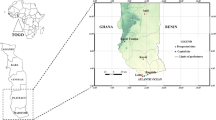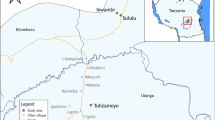Abstract
Field populations of Colombian malaria vector Anopheles (N.) nuneztovari were studied using World Health Organization (WHO) and Center for Disease Control and Prevention (CDC) bioassay techniques and through the use of biochemical microplate-based assays for resistance enzymes. Insecticides evaluated included the pyrethroids lambda-cyhalothrin and deltamethrin, organophosphates malathion and fenitrothion, and the organochlorine dichlorodiphenyltrichloroethane (DDT). Study sites selected were based upon malaria incidence, vector presence, and control activities in Colombia. Early stage selection for reduced susceptibility was observed in the bioassays for some locations. Data from the WHO and CDC bioassay methods were broadly consistent, with some differences noted. Evidence is presented for low-level initial selection of some resistance mechanisms such as mixed-function oxidases and modified acetylcholinesterase. Data from the site Encharcazón implies that selection for DDT-pyrethroid cross-resistance has occurred, though not likely at a level that currently threatens vector control by either class of insecticides, and further implies that knockdown resistance (kdr) may be present in those populations. Further studies using synergists and development of a kdr-specific assay for A. nuneztovari thus become priorities. The resistance levels to lambda-cyhalothrin and deltamethrin found in the Encharcazón population are of concern since these two insecticides are currently used for both indoor spraying and treated nets. In addition, the resistance to fenitrothion, the indoor spray insecticide mostly used for this species due to their exophilic behavior, found in the El Zulia population, makes urgent to find alternatives for chemical control in these areas. These data provide the initial baselines for insecticide susceptibility profiles for A. nuneztovari in Colombia and the first report of insecticide resistance in this vector.



Similar content being viewed by others
References
Abbott WS (1925) A method of computing the effectiveness of an insecticide. J Econ Entomol 18:265–267
Boyer S, David JP, Lemperière G, Ravanel P (2006) Response of Aedes aegypti (Diptera: Culicidae) larvae to 3 xenobiotics exposure: larval tolerance and detoxifying enzyme activities. Environ Toxicol Chem 25:470–476
Brogdon WG (1984a) Mosquito protein microassay. I. Protein determinations from small portions of single-mosquito homogenates. Comp Biochem Physiol B 79:457–459
Brogdon WG (1984b) Mosquito protein microassay. II. Modification for potential field use. Comp Biochem Physiol B 79:461–464
Brogdon WG (1988) Microassay of acetylcholinesterase activity in small portions of single mosquito homogenates. Comp Biochem Physiol C 90:145–150
Brogdon WG, Barber AM (1990a) Microplate assay of glutathione s-transferase activity for resistance detection in single-mosquito triturates. Comp Biochem Physiol B 96:339–342
Brogdon WG, Barber AM (1990b) Fenitrothion-deltamethrin cross-resistance conferred by esterases in Guatemalan Anopheles albimanus. Pestic Biochem Physiol 3:130–139
Brogdon WG, McAllister JC (1998) Resistance and vector control. Emerg Infect Dis 4:605–613
Brogdon WG, Beach RF, Stewart JM, Castanaza L (1988) Microplate assay analysis of the distribution of organophosphate and carbamate resistance in Guatemalan Anopheles albimanus. Bull World Health Organ 66:339–346
Brogdon WG, McAllister JC, Vulule J (1997) Heme peroxidase activity measured in single mosquitoes identifies individuals expressing the elevated oxidase mechanism for insecticide resistance. J Am Mosq Control Assoc 13:233–237
Brooke BD, Kloke G, Hunt RH, Koekemoer LL, Temu EA, Taylor ME, Small G, Hemingway J, Coetzee M (2001) Bioassay and biochemical analyses of insecticide resistance in southern African Anopheles funestus (Diptera: Culicidae). Bull Entomol Res 91:265–272
Casimiro S, Coleman M, Hemingway J, Sharp B (2006) Insecticide resistance in Anopheles arabiensis and Anopheles gambiae from Mozambique. J Med Entomol 43:276–282
Chareonviriyaphap T, Rongnoparut P, Chantarumporn P, Bangs MJ (2003) Biochemical detection of pyrethroid resistance mechanisms in Anopheles minimus in Thailand. J Vector Ecol 28:108–116
Coleman M, Sharp B, Seocharan I, Hemingmay J (2006) Developing an evidence-based decision support system for racional insecticides choice in the control of African malaria vectors. J Med Entomol 43:663–668
Dame D (1998) Maintenance of susceptibility to mosquito insecticides. Wing Beats 9:4–6
Denholm I, Rowland MW (1992) Tactics for managing pesticide resistance in arthropods: theory and practice. Annu Rev Entomol 37:91–112
Diabaté A, Baldet T, Chandre F, Akogbeto M, Guiguemde TR, Darriet F, Brengues C, Guillet P, Hemingway J, Small G, Hougard JM (2002) The role of agricultural use of insecticides in resistance to pyrethroids in Anopheles gambiae s.l. in Burkina Faso. Am J Trop Med Hyg 67:617–622
Dzul FA, Penilla RP, Rodríguez AD (2007) Susceptibility and insecticide resistance mechanisms in Anopheles albimanus from the southern Yucatan Peninsula, Mexico. Salud Publica Mex 49:302–311
Escalante AA, Cornejo OE, Rojas A, Udhayakumar V, Lal AA (2004) Assessing the effect of natural selection in malaria parasites. Trends Parasitol 20:388–395
Faran M, Linthicum K (1981) A handbook of the Amazonian species of Anopheles (Nyssorhynchus) (Diptera: Culicidae). Mosq Syst 13:1–81
Federici BA, Park HW, Bideshi DK, Wirth MC, Johnson JJ (2003) Recombinant bacteria for mosquito control. J Exp Biol 206:3877–3885
Fonseca-González I (2008) Estatus de la resistencia a insecticidas de los vectores primarios de malaria y dengue en Antioquia, Chocó, Norte de Santander y Putumayo, Colombia, PhD Thesis, Universidad de Antioquia, Colombia, pp 183
Georghiou GP, Breeland SG, Ariaratnam V (1973) Seasonal escalation of organophosphorus and carbamate resistance in Anopheles albimanus by agricultural sprays. Environ Entomol 2:369–374
Hargreaves K, Koekemoer LL, Brooke BD, Hunt RH, Mthembu J, Coetzee M (2000) Anopheles funestus resistant to pyrethroid insecticides in South Africa. Med Vet Entomol 14:1–9
Hargreaves K, Hunt RH, Brooke BD, Mthembu J, Weeto MM, Awolola TS, Coetzee M (2003) Anopheles arabiensis and An. quadriannulatus resistance to DDT in South Africa. Med Vet Entomol 17:417–422
Hemingway J, Karunaratne SHPP (1998) Mosquito carboxylesterases: a review of molecular biology and biochemistry of a major insecticide resistance mechanism. Med Vet Entomol 12:1–12
Hemingway J, Ranson H (2000) Insecticide resistance in insect vectors of human disease. Annu Rev Entomol 45:371–391
Instituto Nacional de Salud, Ministerio de la Protección Social, INS (2007) Boletín Epidemiológico Semanal. Sistema Nacional de Vigilancia en Salud Pública-SIVIGILA. Semana Epidemiológica 52 Diciembre 23–29. Ministerio de la Protección Social, Bogota, Colombia
IRAC (2006) Prevention and management of insecticide resistance in vectors and pests of public health importance. The Insecticide Resistance Action Committee. http://www.irac-online.org
Kostaropoulos I, Papadopoulos AI, Metaxakis A, Boukouvala E, Papadopoulou-Mourkidou E (2001) Glutathione S-transferase in the defence against pyrethroids in insects. Insect Biochem Mol Biol 31:313–319
Krzywinski J, Besansky N (2003) Molecular systematics of Anopheles: from subgenera to subpopulations. Annu Rev Entomol 48:111–139
Martinez-Torres D, Chandre F, Williamson MS, Darriet F, Berge JB, Devonshirre AL, Guillet P, Pasteur N, Pauron D (1998) Molecular characterization of pyrethroid knockdown resistance (kdr) in the major malaria vector Anopheles gambiae s.s. Insect Mol Biol 7:179–184
Najera JA, Zaim M (2002) Malaria vector control: decision making criteria and procedures for judicious use of insecticides. WHO Pesticide Evaluation Scheme (WHOPES), Geneva. WHO/CDS/WHOPES/2002.5. Rev.1, p 122
Ocampo CB, Brogdon WG, Orrego CM, Toro G, Montoya-Lerma J (2000) Insecticide susceptibility in Anopheles pseudopunctipennis from Colombia: comparison between bioassays and biochemical assays. J Am Mosq Control Assoc 16:331–338
Olano VA, Brochero HL, Saénz R, Quiñones ML, Molina JA (2001) Mapas preliminares de la distribución de especies de Anopheles vectores de malaria en Colombia. Biomédica 21:402–408
Penilla RP, Rodríguez AD, Hemingway J, Torres JL, Arredondo-Jimenez JI, Rodríguez MH (1998) Resistance management strategies in malaria vector mosquito control. Baseline data for a large-scale field trial against Anopheles albimanus in Mexico. Med Vet Entomol 12:217–233
Quiñones ML, Suarez MF, Fleming GA (1987) Estado de la susceptibilidad al DDT de los principales vectores de malaria en Colombia y su implicación epidemiológica. Biomédica 7:81–86
Rubio-Palis Y (2000) Anopheles (Nyssorhynchus) de Venezuela. Taxonomía, bionomía, ecología e importancia médica. Publicado por la Escuela de Malariología y Saneamiento Ambiental “Dr. Arnoldo Gabaldon” y el Proyecto Control de Enfermedades Endémicas. Maracay, Venezuela, p 120
Rubio-Palis Y, Zimmerman RH (1997) Ecoregional classification of malaria vectors in the Neotropics. J Med Entomol 34:499–510
Ruiz F, Quiñones ML, Erazo HF, Calle DA, Alzate JF, Linton IM (2005) Molecular differentiation of Anopheles (Nyssorhynchus) benarrochi an An. (N.) oswaldoi from Southern Colombia. Mem Inst Oswaldo Cruz 100:155–160
Scorza JV, Tallaferro E, Rubiano H (1976) Comportamiento y susceptibilidad de Anopheles nuneztovari Gabaldon, 1940 a la infección por Plasmodium falciparum y Plasmodium vivax. Bol Dir Malariol Saneam Ambient 16:129–136
Scott JG, Wen Z (2001) Cytochromes P450 of insects: the tip of the iceberg. Pest Manag Sci 57:958–967
Scott JG, Liu N, Wen ZM (1998) Insect cytochromes P450: diversity, insecticide resistance and tolerance to plant toxins. Comp Biochem Physiol 121:147–155
Soderlund DM (2008) Pyrethroids, knockdown resistance and sodium channels. Pest Manag Sci 64:610–616
Vulule JM, Beach RF, Atieli FK, McAllister JC, Brogdon WG, Roberts JM, Mwangi RW, Hawley WA (1999) Elevated oxidase and esterase levels associated with permethrin tolerance in Anopheles gambiae from Kenya villages using permethrin impregnated bednets. Med Vet Entomol 13:239–244
Weill M, Fort P, Berthomieu A, Dubois MP, Pasteur N, Raymond M (2002) A novel acetylcholinesterase gene in mosquitoes codes for the insecticide target and is non-homologous to the ace gene in Drosophila. Proc R Soc Lond B Biol Sci 269:2007–2016
Weill M, Lutfalla G, Mogensen K, Chandre F, Berthomieu A, Berticat C, Pasteur N, Phillips A, Fort P, Raymond M (2003) Insecticide resistance in mosquito vector. Nature 423:136–137
Weill M, Malcolm C, Chandre F, Mogensen K, Berthomieu A, Marquine M, Raymond M (2004) The unique mutation in ace-1 giving high insecticide resistance is easily detectable in mosquito vectors. Insect Mol Biol 3:1–7
World Health Organization (1981) Instructions for determining the susceptibility or resistance of adult mosquitoes to organochlorine, organophosphate and carbamate insecticides—diagnostic test. WHO/VBC/81.806. World Health Organization Document, Geneva
World Health Organization (1992) Vector resistance to pesticides. Fifteenth report of the expert committee on vector biology and control. WHO Tech Rep Ser No 818, World Health Organization, Geneva, p 55
World Health Organization (1998) Test procedures for insecticide resistance monitoring in malaria vectors, bio-efficacy and persistence of insecticides on treated surfaces. WHO/CDS/CPC/MAL/98.12. World Health Organization, Geneva
Zimmerman RH (1992) Ecology of malaria vectors in the Americas and future direction. Mem Inst Oswaldo Cruz 87:371–383
Acknowledgments
We acknowledge the Coordinators and the staff of the Vector Borne Diseases Sections from Antioquia, Chocó, and Norte de Santander Health Secretaries; in particular to the Entomologists Silvia Díaz, José Dolores Palacios, Wilber Gómez, David Calle, and Eulides Pabón for their collaboration with biological collections and CDC bioassays. All experimental procedures comply with the criteria of the Ethical Committee of the University of Antioquia in agreement with the current laws of Colombia.
Author information
Authors and Affiliations
Corresponding author
Additional information
This work was financed by the Instituto Colombiano para el Desarrollo de la Ciencia y la Tecnología “Francisco José de Caldas” COLCIENCIAS (Grant number 22290416444) and Comité de Investigación CODI, Universidad de Antioquia. Idalyd Fonseca-González obtained financial support for her doctoral training from COLCIENCIAS.
Rights and permissions
About this article
Cite this article
Fonseca-González, I., Cárdenas, R., Quiñones, M.L. et al. Pyrethroid and organophosphates resistance in Anopheles (N.) nuneztovari Gabaldón populations from malaria endemic areas in Colombia. Parasitol Res 105, 1399–1409 (2009). https://doi.org/10.1007/s00436-009-1570-2
Received:
Accepted:
Published:
Issue Date:
DOI: https://doi.org/10.1007/s00436-009-1570-2




